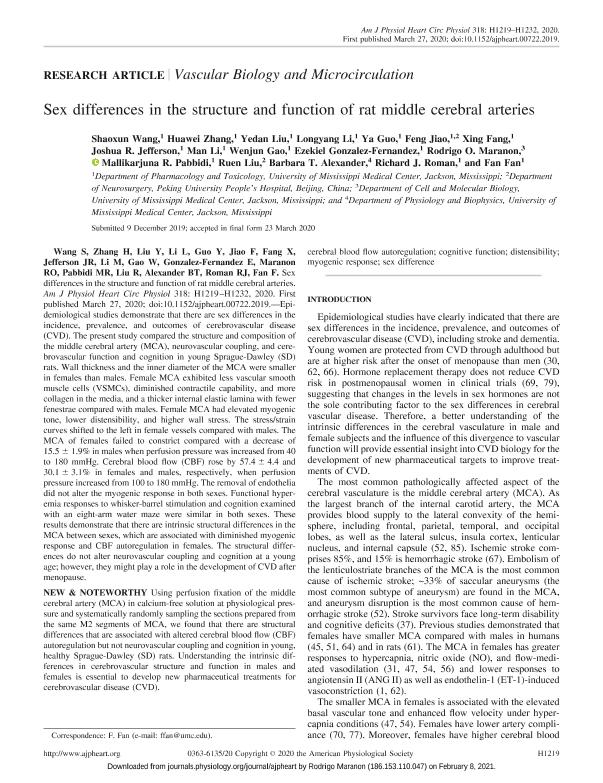Artículo
Sex differences in the structure and function of rat middle cerebral arteries
Wang, Shaoxun; Zhang, Huawei; Liu, Yedan; Li, Longyang; Guo, Ya; Jiao, Feng; Fang, Xing; Jefferson, Joshua R.; Li, Man; Gao, Wenjun; Gonzalez Fernandez, Ezekiel; Marañón, Rodrigo Oscar ; Pabbidi, Mallikarjuna R.; Liu, Ruen; Alexander, Barbara T.; Roman, Richard J.; Fan, Fan
; Pabbidi, Mallikarjuna R.; Liu, Ruen; Alexander, Barbara T.; Roman, Richard J.; Fan, Fan
 ; Pabbidi, Mallikarjuna R.; Liu, Ruen; Alexander, Barbara T.; Roman, Richard J.; Fan, Fan
; Pabbidi, Mallikarjuna R.; Liu, Ruen; Alexander, Barbara T.; Roman, Richard J.; Fan, Fan
Fecha de publicación:
05/2020
Editorial:
American Physiological Society
Revista:
American Journal of Physiology - Heart and Circulatory Physiology
ISSN:
0363-6135
Idioma:
Inglés
Tipo de recurso:
Artículo publicado
Clasificación temática:
Resumen
Wang S, Zhang H, Liu Y, Li L, Guo Y, Jiao F, Fang X, Jefferson JR, Li M, Gao W, Gonzalez-Fernandez E, Maranon RO, Pabbidi MR, Liu R, Alexander BT, Roman RJ, Fan F. Sex differences in the structure and function of rat middle cerebral arteries. Am J Physiol Heart Circ Physiol 318: H1219 –H1232, 2020. First published March 27, 2020; doi:10.1152/ajpheart.00722.2019.—Epidemiological studies demonstrate that there are sex differences in the incidence, prevalence, and outcomes of cerebrovascular disease (CVD). The present study compared the structure and composition of the middle cerebral artery (MCA), neurovascular coupling, and cerebrovascular function and cognition in young Sprague-Dawley (SD) rats. Wall thickness and the inner diameter of the MCA were smaller in females than males. Female MCA exhibited less vascular smooth muscle cells (VSMCs), diminished contractile capability, and more collagen in the media, and a thicker internal elastic lamina with fewer fenestrae compared with males. Female MCA had elevated myogenic tone, lower distensibility, and higher wall stress. The stress/strain curves shifted to the left in female vessels compared with males. The MCA of females failed to constrict compared with a decrease of 15.5 ± 1.9% in males when perfusion pressure was increased from 40 to 180 mmHg. Cerebral blood flow (CBF) rose by 57.4 ± 4.4 and 30.1 ± 3.1% in females and males, respectively, when perfusion pressure increased from 100 to 180 mmHg. The removal of endothelia did not alter the myogenic response in both sexes. Functional hyperemia responses to whisker-barrel stimulation and cognition examined with an eight-arm water maze were similar in both sexes. These results demonstrate that there are intrinsic structural differences in the MCA between sexes, which are associated with diminished myogenic response and CBF autoregulation in females. The structural differences do not alter neurovascular coupling and cognition at a young age; however, they might play a role in the development of CVD after menopause. NEW & NOTEWORTHY Using perfusion fixation of the middle cerebral artery (MCA) in calcium-free solution at physiological pressure and systematically randomly sampling the sections prepared from the same M2 segments of MCA, we found that there are structural differences that are associated with altered cerebral blood flow (CBF) autoregulation but not neurovascular coupling and cognition in young, healthy Sprague-Dawley (SD) rats. Understanding the intrinsic differences in cerebrovascular structure and function in males and females is essential to develop new pharmaceutical treatments for cerebrovascular disease (CVD).
Archivos asociados
Licencia
Identificadores
Colecciones
Articulos(CCT - NOA SUR)
Articulos de CTRO.CIENTIFICO TECNOL.CONICET - NOA SUR
Articulos de CTRO.CIENTIFICO TECNOL.CONICET - NOA SUR
Citación
Wang, Shaoxun; Zhang, Huawei; Liu, Yedan; Li, Longyang; Guo, Ya; et al.; Sex differences in the structure and function of rat middle cerebral arteries; American Physiological Society; American Journal of Physiology - Heart and Circulatory Physiology; 318; 5; 5-2020; 1219-1232
Compartir
Altmétricas



